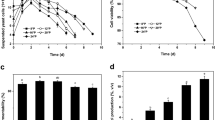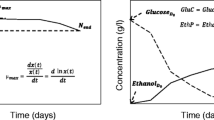Abstract
Significant positive correlations between wort fermentability and the assimilation of Lys and His under normal-gravity and high-gravity conditions indicated that Lys and His were the key amino acids for lager yeast during beer brewing. In order to obtain insight into the roles of Lys and His in nitrogen regulation, the influences of Lys, His and their mixture supplementations on the fermentation performance and nitrogen metabolism in lager yeast during high-gravity fermentation were further investigated in the present study. Results showed that Lys and His supplementations improved yeast growth, wort fermentability, ethanol yield and the formation of flavor volatiles. Lys supplementation up-regulated Ssy1p–Ptr3p–Ssy5p (SPS)-regulated genes (LYP1, HIP1, BAP2 and AGP1) dramatically compared to nitrogen catabolite repression (NCR)-sensitive genes (GAP1 and MEP2), whereas His supplementation activated SPS-regulated genes slightly in exponential phase, and repressed NCR-sensitive genes significantly throughout the fermentation. Lys and His supplementations increased the consumption of Glu and Phe, and decreased the consumption of Ser, Trp and Arg. Moreover, Lys and His supplementations exhibited similar effects on the fermentation performance, and were more effective than their mixture supplementation when the same dose was kept. These results demonstrate that both Lys and His are important amino acids for yeast nitrogen metabolism and fermentation performance.


Similar content being viewed by others
References
Beltran G, Esteve-Zarzoso B, Rozès N, Mas A, Guillamón JM (2005) Influence of the timing of nitrogen additions during synthetic grape must fermentations on fermentation kinetics and nitrogen consumption. J Agric Food Chem 53:996–1002
Beltran G, Novo M, Rozès N, Mas A, Guillamón JM (2004) Nitrogen catabolite repression in Saccharomyces cerevisiae during wine fermentations. FEMS Yeast Res 4:625–632
Beltran G, Rozès N, Mas A, Guillamón JM (2007) Effect of low-temperature fermentation on yeast nitrogen metabolism. World J Microbiol Biotechnol 23:809–815
Crépin L, Nidelet T, Sanchez I, Dequin S, Camarasa C (2012) Sequential use of nitrogen compounds by Saccharomyces cerevisiae during wine fermentation: a model based on kinetic and regulation characteristics of nitrogen permeases. Appl Environ Microbiol 78:8102–8111
Deed NK, van Vuuren HJJ, Gardner RC (2011) Effects of nitrogen catabolite repression and di-ammonium phosphate addition during wine fermentation by a commercial strain of S. cerevisiae. Appl Microbiol Biotechnol 89:1537–1549
Fleet GH (2003) Yeast interactions and wine flavour. Int J Food Microbiol 86:11–22
Fleet GH (2008) Wine yeasts for the future. FEMS Yeast Res 8:979–995
Forsberg H, Ljungdahl PO (2001) Genetic and biochemical analysis of the yeast plasma membrane Ssy1p–Ptr3p–Ssy5p sensor of extracellular amino acids. Mol Cell Biol 21:814–826
Georis I, Feller A, Vierendeels F, Dubois E (2009) The yeast GATA factor Gat1 occupies a central position in nitrogen catabolite repression-sensitive gene activation. Mol Cell Biol 29:3803–3815
Guillamon JM, van Riel NA, Giuseppin ML, Verrips CT (2001) The glutamate synthase (GOGAT) of Saccharomyces cerevisiae plays an important role in central nitrogen metabolism. FEMS Yeast Res 1:169–175
Hazelwood LA, Daran J-M, van Maris AJA, Pronk JT, Dickinson JR (2008) The Ehrlich pathway for fusel alcohol production: a century of research on Saccharomyces cerevisiae metabolism. Appl Environ Microbiol 74:2259–2266
Lei HJ, Zhao HF, Yu ZM, Zhao MM (2012) Effects of wort gravity and nitrogen level on fermentation performance of brewer's yeast and the formation of flavor volatiles. Appl Biochem Biotech 166:1562–1574
Lei HJ, Zhao HF, Zhao MM (2013a) Proteases supplementation to high gravity worts enhances fermentation performance of brewer's yeast. Biochem Eng J 77:1–6
Lei HJ, Zheng LY, Wang CX, Zhao HF, Zhao MM (2013b) Effects of worts treated with proteases on the assimilation of free amino acids and fermentation performance of lager yeast. Int J Food Microbiol 161:76–83
Lekkas C, Stewart GG, Hill AE, Taidi B, Hodgson J (2007) Elucidation of the role of nitrogenous wort components in yeast fermentation. J Inst Brew 113:3–8
Ljungdahl PO (2009) Amino-acid-induced signalling via the SPS-sensing pathway in yeast. Biochem Soc T 37:242–247
Magasanik B, Kaiser CA (2002) Nitrogen regulation in Saccharomyces cerevisiae. Gene 290:1–18
Marini AM, Soussi-Boudekou S, Vissers S, André B (1997) A family of ammonium transporters in Saccharomyces cerevisiae. Mol Cell Biol 17:4282–4293
O'Connor-Cox ESC, Ingledew WM (1989) Wort nitrogenous sources their use by brewing yeasts: a review. J Am Soc Brew Chem 47:102–108
Perpète P, Santos G, Bodart E, Collin S (2005) Uptake of amino acids during beer production: the concept of a critical time value. J Am Soc Brew Chem 59:157–162
Pfaffl MW (2001) A new mathematical model for relative quantification in real-time RT-PCR. Nucleic Acids Res 29:2002–2007
Piddocke MP, Kreisz S, Heldt-Hansen HP, Nielsen KF, Olsson L (2009) Physiological characterization of brewer's yeast in high-gravity beer fermentations with glucose or maltose syrups as adjuncts. Appl Microbiol Biotechnol 84:453–464
Pierce JS (1987) The role of nitrogen in brewing. J Inst Brew 93:378–381
Pinho O, Ferreira IMPLVO, Santos LHMLM (2006) Method optimization by solid-phase microextraction in combination with gas chromatography with mass spectrometry for analysis of beer volatile fraction. J Chromatogr A 1121:145–153
Puligundla P, Smogrovicova D, Obulam VSR, Ko S (2011) Very high gravity (VHG) ethanolic brewing and fermentation: a research update. J Ind Microbiol Biotechnol 38:1133–1144
Saerens SMG, Delvaux FR, Verstrepen KJ, Thevelein JM (2010) Production and biological function of volatile esters in Saccharomyces cerevisiae. Microb Biotechnol 3:165–177
Saerens SMG, Verbelen PJ, Vanbeneden N, Thevelein JM, Delvaux FR (2008) Monitoring the influence of high-gravity brewing and fermentation temperature on flavour formation by analysis of gene expression levels in brewing yeast. Appl Microbiol Biotechnol 80:1039–1051
Schure EG, Riel NAW, Verrips CT (2000) The role of ammonia metabolism in nitrogen catabolite repression in Saccharomyces cerevisiae. FEMS Microbiol Rev 24:67–83
Slininger PJ, Dien BS, Gorsich SW, Liu ZL (2006) Nitrogen source and mineral optimization enhance d-xylose conversion to ethanol by the yeast Pichia stipites NRRL Y-7124. Appl Microbiol Biotechnol 72:1285–1296
Stanbrough M, Magasanik B (1995) Transcriptional and posttranslational regulation of the general amino acid permease of Saccharomyces cerevisiae. J Bacteriol 177:94–102
Verbelen PJ, Dekoninck TML, Saerens SMG, Van Mulders SE, Thevelein JM, Delvaux FR (2009) Impact of pitching rate on yeast fermentation performance and beer flavour. Appl Microbiol Biotechnol 82:155–167
Younis O, Stewart G (1998) Sugar uptake and subsequent ester and higher alcohol production by Saccharomyces cerevisiae. J Inst Brew 104:255–264
Acknowledgments
The authors gratefully acknowledge the National Science–Technology Supporting Project for 12th Five-Year Plan (No. 2013AA102108-6), the Key Technology R&D Program of Guangdong Province (No. 2012A080107005) and the Fundamental Research Funds for the Central Universities (No. 2012ZM0069) for their financial support.
Author information
Authors and Affiliations
Corresponding authors
Rights and permissions
About this article
Cite this article
Lei, H., Li, H., Mo, F. et al. Effects of Lys and His supplementations on the regulation of nitrogen metabolism in lager yeast. Appl Microbiol Biotechnol 97, 8913–8921 (2013). https://doi.org/10.1007/s00253-013-5137-x
Received:
Revised:
Accepted:
Published:
Issue Date:
DOI: https://doi.org/10.1007/s00253-013-5137-x




